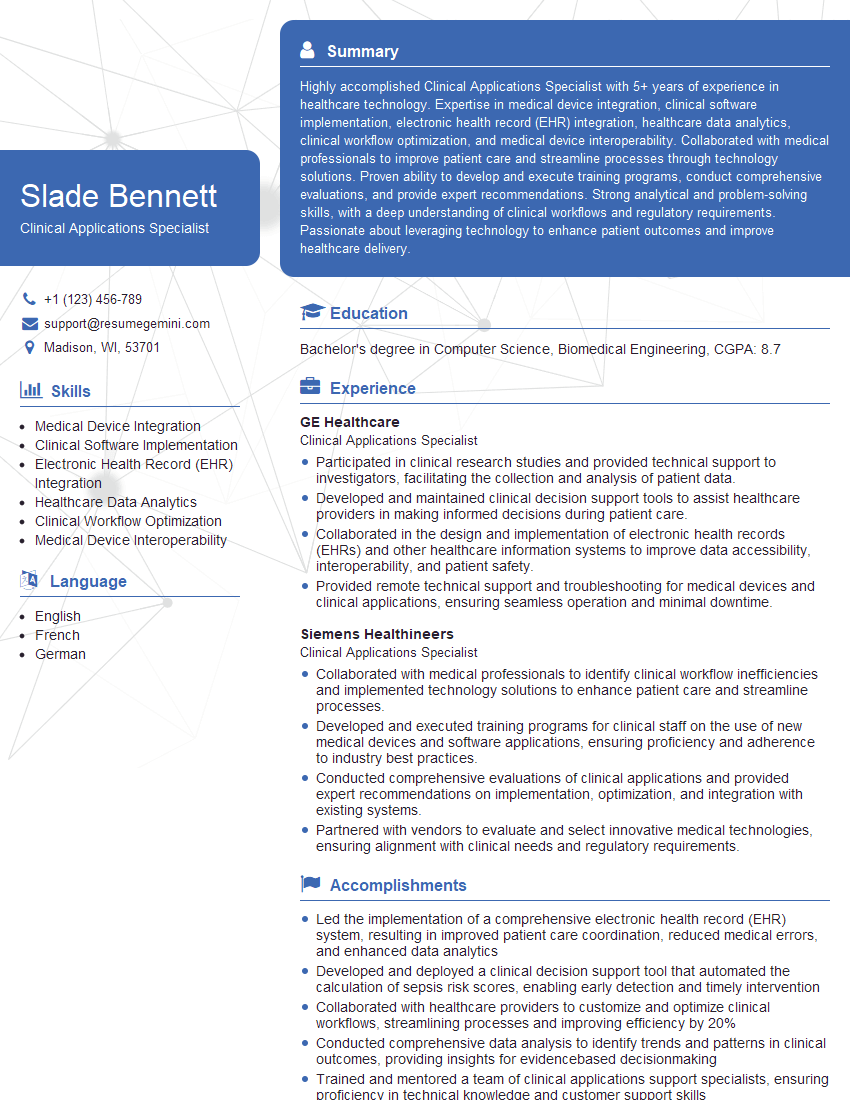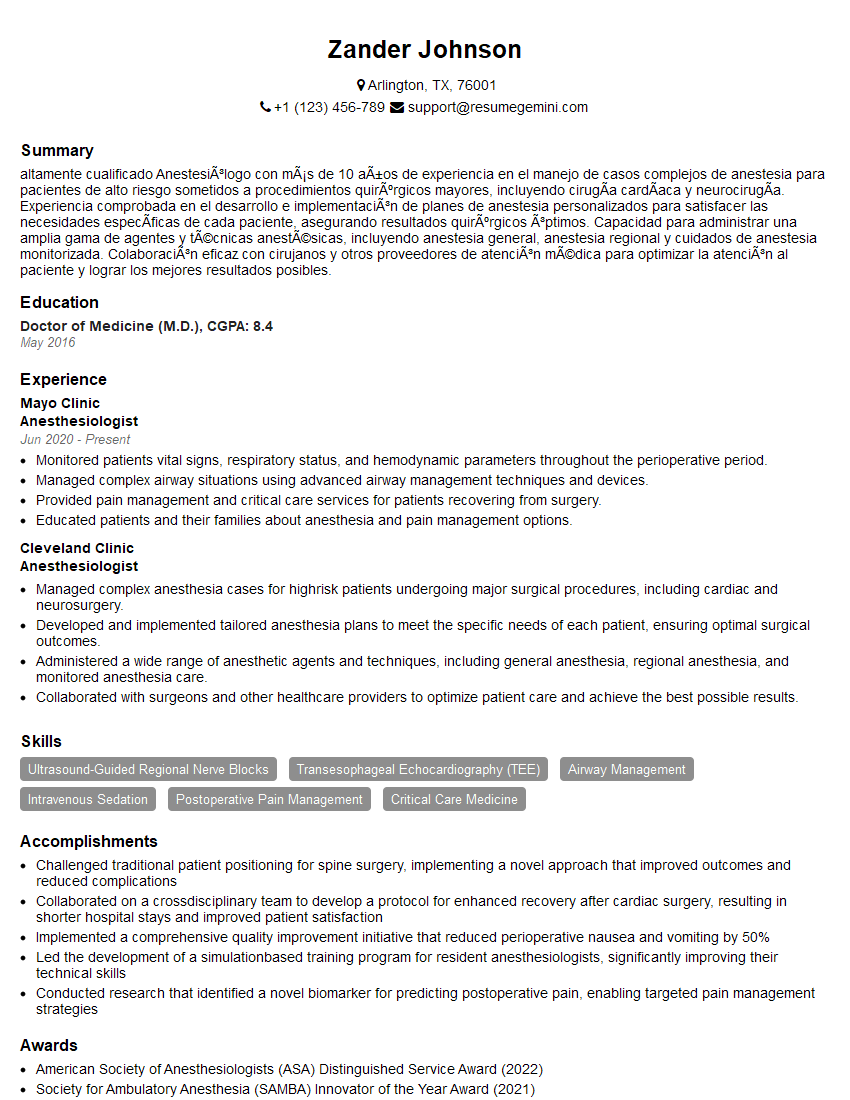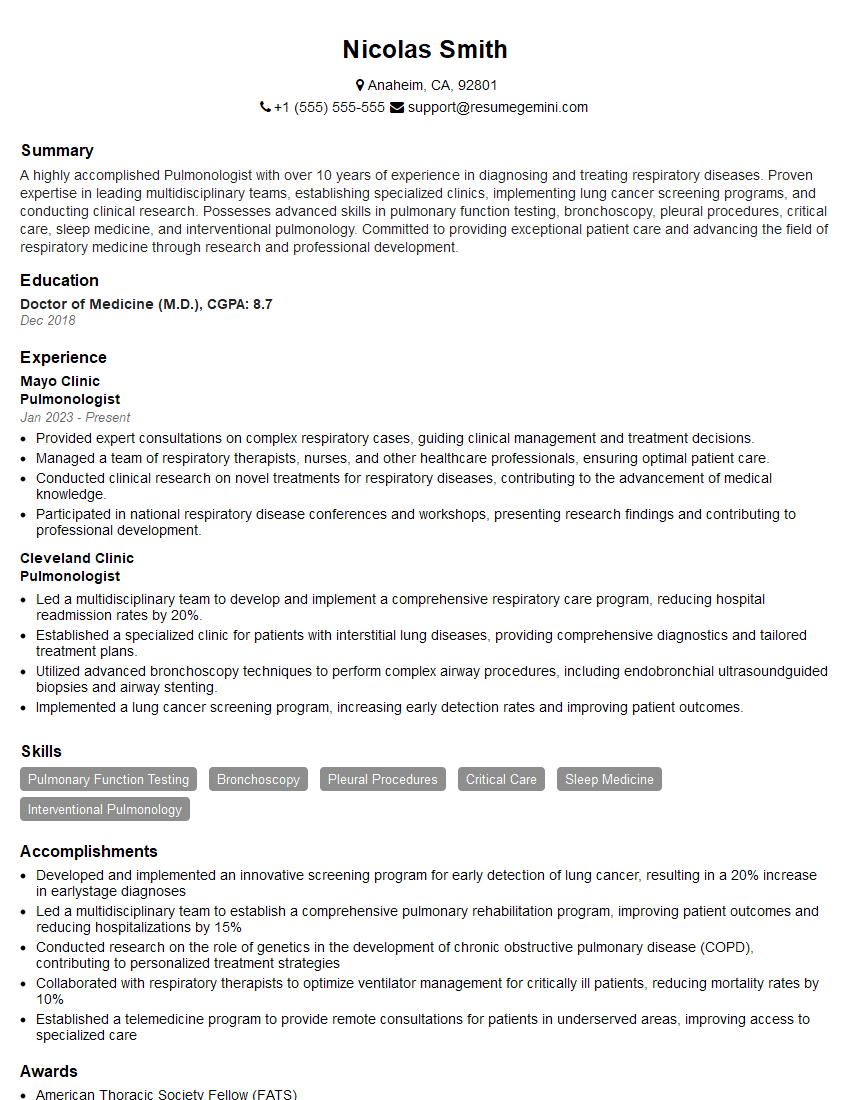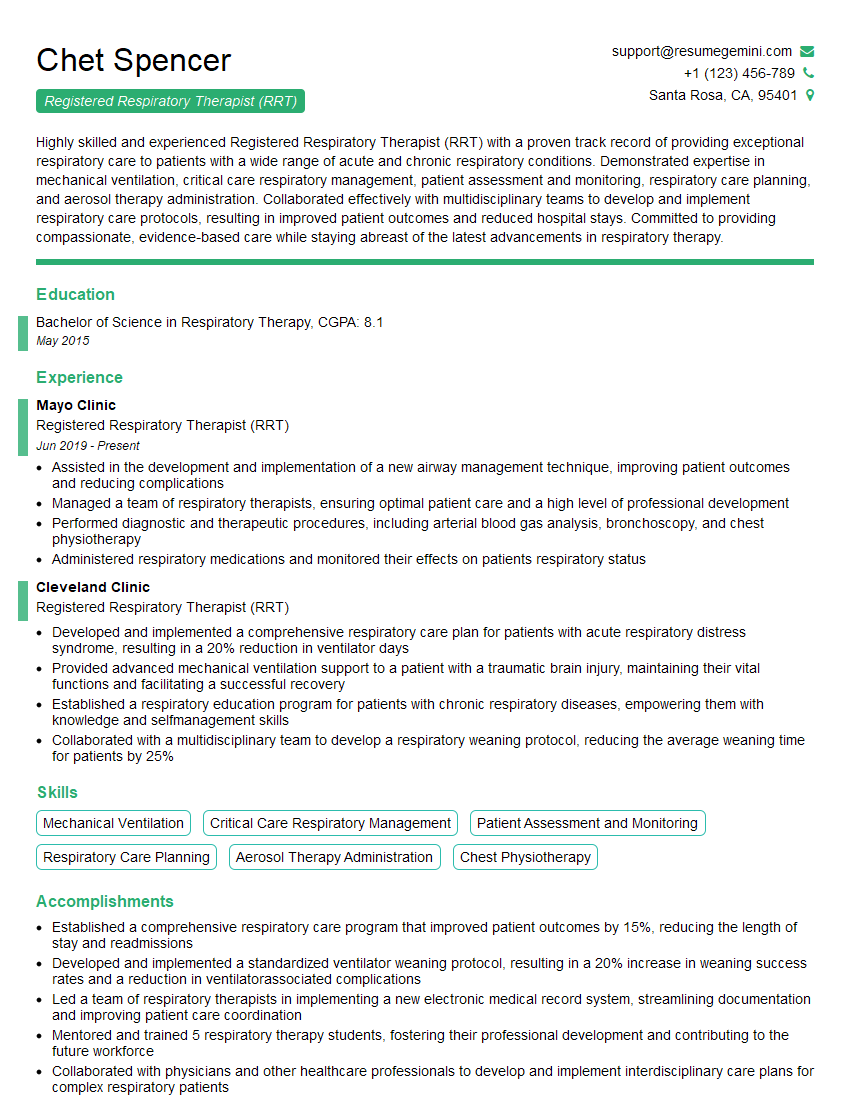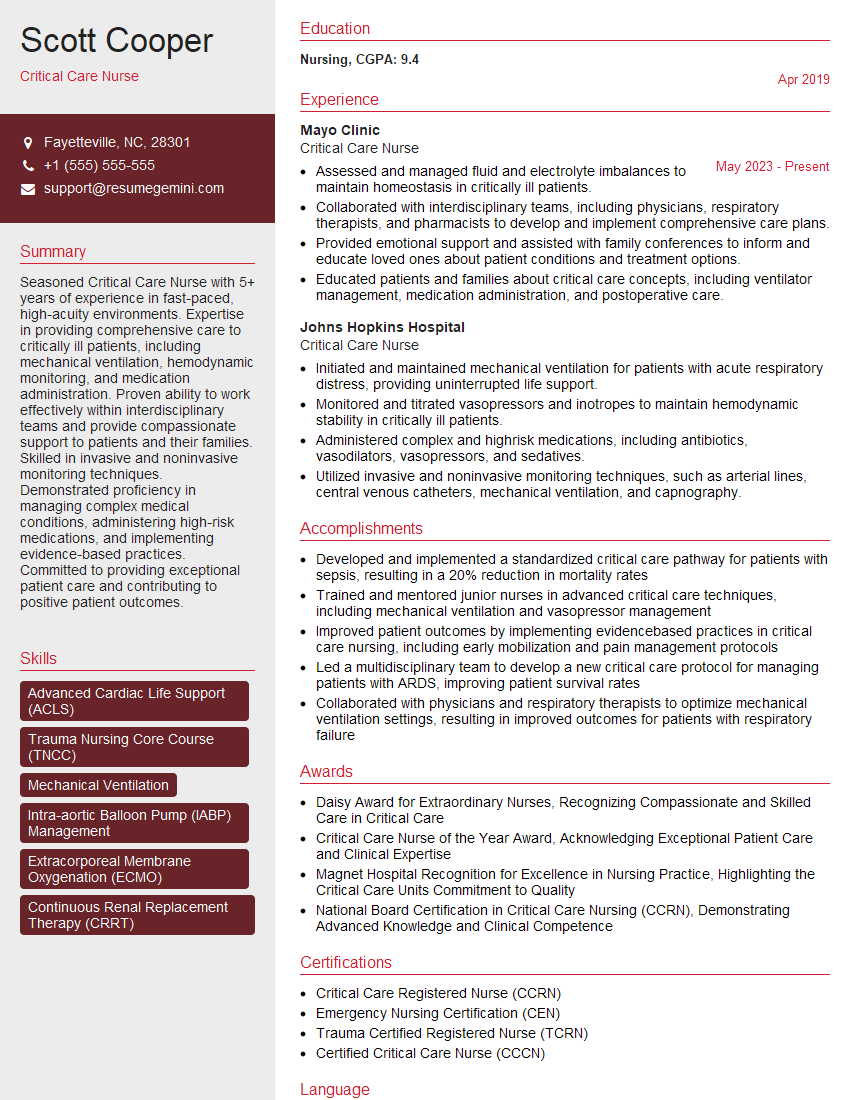Preparation is the key to success in any interview. In this post, we’ll explore crucial Tidal Volume Monitoring interview questions and equip you with strategies to craft impactful answers. Whether you’re a beginner or a pro, these tips will elevate your preparation.
Questions Asked in Tidal Volume Monitoring Interview
Q 1. Define tidal volume and its significance in respiratory care.
Tidal volume (Vt) is the volume of air inhaled or exhaled during a normal breath. It’s a fundamental parameter in respiratory physiology, representing the amount of air exchanged between the lungs and the atmosphere with each respiratory cycle. Its significance lies in its direct relationship to the overall efficiency of gas exchange – the process of oxygen uptake and carbon dioxide removal. Adequate tidal volume ensures sufficient oxygen reaches the bloodstream and carbon dioxide is effectively expelled.
Q 2. Explain the different methods for measuring tidal volume.
Several methods exist for measuring tidal volume, each with its own advantages and disadvantages:
- Pneumotachography: This method uses a pneumotachograph, a device that measures airflow. The integrated airflow over a respiratory cycle directly provides the tidal volume. It’s highly accurate but can be cumbersome to use.
- Spirometry: Spirometry measures lung volumes and capacities, including tidal volume. This is a widely available and relatively inexpensive technique used routinely in pulmonary function testing. Different types of spirometers exist, offering varying levels of accuracy and portability.
- Respiratory Inductive Plethysmography (RIP): RIP uses bands placed around the chest and abdomen to measure changes in thoracic and abdominal volume, providing an indirect measurement of tidal volume. It’s a non-invasive method suitable for monitoring tidal volume in various settings, including during sleep studies.
- Ultrasound: Lung ultrasound can indirectly estimate tidal volume by assessing changes in lung dimensions during breathing. This method has gained traction in critical care settings, complementing other monitoring techniques.
- Mechanical Ventilators: Ventilators directly measure tidal volume delivered to the patient. This is crucial in mechanically ventilated patients, allowing precise control of ventilation.
The choice of method depends on the clinical context, available resources, and the desired level of accuracy.
Q 3. Describe the normal range of tidal volume for an adult.
The normal tidal volume for a healthy adult typically ranges from 5 to 7.5 mL/kg of ideal body weight, or approximately 500-750 mL for an average-sized adult. However, this is just a guideline, and individual values can vary depending on factors such as age, sex, height, and overall fitness. A smaller tidal volume might indicate restrictive lung disease, while an unusually large tidal volume might hint at compensatory mechanisms for increased respiratory demand.
Q 4. How does tidal volume relate to minute ventilation?
Minute ventilation (VE) represents the total volume of air moved in and out of the lungs per minute. It’s calculated by multiplying tidal volume (Vt) by the respiratory rate (RR):
VE = Vt x RR
For example, if a patient has a tidal volume of 500 mL and a respiratory rate of 12 breaths per minute, their minute ventilation would be 6000 mL/min or 6 L/min. Minute ventilation is a crucial indicator of overall respiratory function, providing a measure of alveolar ventilation, which is directly related to the arterial blood gas levels.
Q 5. What factors can influence tidal volume?
Several factors can influence tidal volume:
- Lung Compliance: Reduced lung compliance (stiff lungs) due to conditions like pulmonary fibrosis will decrease tidal volume. Imagine trying to inflate a stiff balloon—it requires more effort and results in a smaller volume.
- Airway Resistance: Increased airway resistance from bronchospasm or secretions makes it harder to move air in and out, thus reducing tidal volume.
- Body Position: Tidal volume can vary depending on the body position. For example, lying supine might reduce tidal volume compared to sitting upright.
- Conscious Effort: Individuals can consciously control their breathing, increasing or decreasing tidal volume within certain limits. For instance, during exercise, people consciously increase their tidal volume.
- Level of Anesthesia: Anesthesia can depress respiratory drive and reduce tidal volume.
Q 6. Explain the concept of tidal volume variability.
Tidal volume variability (TVV) refers to the beat-to-beat variation in tidal volume. It’s an important physiological parameter reflecting the respiratory system’s response to various stimuli. Healthy individuals exhibit a certain degree of TVV, primarily driven by the inherent variability in respiratory neuron firing. However, significantly increased or decreased TVV can signal underlying respiratory problems. For instance, increased TVV might suggest impaired respiratory control, while decreased TVV may indicate respiratory muscle fatigue or impending respiratory failure.
Monitoring TVV is particularly useful in critical care settings where subtle changes in respiratory function can have significant clinical implications.
Q 7. How is tidal volume used in the assessment of respiratory function?
Tidal volume is a cornerstone in assessing respiratory function. It provides crucial information about:
- Ventilation Adequacy: Low tidal volume indicates inadequate ventilation, potentially leading to hypoxemia (low blood oxygen) and hypercapnia (high blood carbon dioxide).
- Respiratory Muscle Function: Changes in tidal volume can reflect the strength and endurance of respiratory muscles.
- Lung Mechanics: Tidal volume is influenced by lung compliance and airway resistance, providing insights into the mechanical properties of the lungs.
- Response to Therapy: Monitoring tidal volume is vital for assessing the effectiveness of interventions like bronchodilators or mechanical ventilation.
In summary, tidal volume is not merely a single measurement; it’s a dynamic indicator that, when considered in context with other respiratory parameters, allows for comprehensive assessment of respiratory function and the patient’s overall clinical status.
Q 8. Describe the clinical significance of low tidal volume.
A low tidal volume, meaning the patient is taking in less air per breath than is ideal, is clinically significant because it indicates inadequate ventilation. This means the lungs aren’t effectively exchanging oxygen and carbon dioxide. Think of it like trying to fill a bucket with a tiny trickle of water – it’s going to take a long time and might not even fill the bucket completely. Insufficient oxygen leads to hypoxemia, while a build-up of carbon dioxide results in hypercapnia. Both can severely compromise organ function and lead to serious complications.
Clinically, we see this in conditions like restrictive lung diseases (e.g., pulmonary fibrosis), neuromuscular weakness (e.g., myasthenia gravis), or inadequate pain control post-surgery, preventing deep breaths. A low tidal volume is a warning sign that the patient needs intervention, perhaps through respiratory support or pain management.
Q 9. Describe the clinical significance of high tidal volume.
A high tidal volume, while seemingly beneficial (more air per breath), can actually be detrimental. While it increases the volume of air exchanged, excessively large tidal volumes can lead to ventilator-induced lung injury (VILI). Imagine inflating a balloon too much – it’s at risk of bursting. Similarly, over-distending the alveoli (tiny air sacs in the lungs) with excessive tidal volume can damage them, causing inflammation, edema, and reduced gas exchange. This is particularly relevant in patients on mechanical ventilation, where the settings need careful adjustment to avoid this complication.
Conditions that might lead to high tidal volumes (often inadvertently through ventilator settings) include acute respiratory distress syndrome (ARDS) or the need for high levels of respiratory support. Therefore, close monitoring and adjusting the ventilator settings are crucial to prevent VILI.
Q 10. What are the potential complications of inadequate tidal volume?
Inadequate tidal volume, whether too low or too high, carries significant risks. Low tidal volume leads to hypoxemia (low blood oxygen levels) and hypercapnia (high blood carbon dioxide levels). These, in turn, can cause respiratory acidosis (blood becomes too acidic), organ dysfunction, and potentially respiratory failure. In severe cases, this can lead to cardiac arrest.
- Hypoxemia: Leads to reduced oxygen delivery to tissues and organs, causing organ damage.
- Hypercapnia: Causes respiratory acidosis, which disrupts the body’s delicate acid-base balance.
- Atelectasis: Collapse of alveoli due to inadequate inflation.
- Pneumonia: Increased risk of infection due to impaired clearance of secretions.
High tidal volumes, as discussed, primarily risk VILI, leading to inflammation and impaired gas exchange. It’s a delicate balance – adequate but not excessive ventilation is key.
Q 11. How does tidal volume relate to oxygenation and ventilation?
Tidal volume is intrinsically linked to both oxygenation and ventilation. Ventilation refers to the movement of air into and out of the lungs, while oxygenation is the process of getting oxygen into the blood. An adequate tidal volume ensures sufficient air movement (ventilation) to allow for effective gas exchange in the alveoli. This exchange brings oxygen into the blood (oxygenation) and removes carbon dioxide (a waste product of metabolism).
If tidal volume is too low, both ventilation and oxygenation are compromised. Conversely, while a high tidal volume might initially seem to improve ventilation, the risk of VILI ultimately impairs oxygenation. Therefore, the optimal tidal volume ensures both effective ventilation and prevents lung injury, maximizing oxygenation.
Q 12. Explain the role of tidal volume in ventilator management.
Tidal volume is a cornerstone of ventilator management. Ventilators deliver a set volume of air (tidal volume) with each breath. The clinician carefully adjusts the tidal volume based on the patient’s individual needs and respiratory status. A too-low tidal volume can lead to hypoventilation and its complications, while a too-high tidal volume causes VILI. Therefore, the ideal tidal volume aims to provide adequate gas exchange without causing lung damage.
Clinicians often use various strategies like pressure-controlled ventilation or volume-controlled ventilation to manage tidal volume. They also consider factors like the patient’s weight, lung compliance, and overall clinical picture when making adjustments.
Q 13. How do you interpret tidal volume waveforms?
Tidal volume waveforms, displayed on a ventilator monitor, provide a visual representation of the breath delivered to the patient. A normal waveform shows a smooth, symmetrical inspiratory and expiratory phase. Deviations from this pattern can indicate problems. For instance:
- Obstruction: A flattened or distorted waveform suggests airway obstruction, possibly due to secretions or bronchospasm.
- Leakage: A smaller-than-expected waveform may indicate a leak in the ventilator circuit.
- Patient-ventilator asynchrony: This is a mismatch between the patient’s breathing effort and the ventilator’s delivery, seen as irregular waveforms.
Interpreting these waveforms requires experience and clinical judgment. Combining waveform analysis with other clinical data allows clinicians to adjust ventilator settings and ensure optimal respiratory support. Remember, waveform analysis is only one piece of the puzzle; it needs to be correlated with clinical observations, blood gas results, and other physiological parameters.
Q 14. Describe how tidal volume monitoring is used in different clinical settings (e.g., ICU, OR).
Tidal volume monitoring is crucial in various clinical settings:
- ICU (Intensive Care Unit): Critically ill patients often require mechanical ventilation, and continuous tidal volume monitoring is essential for adjusting ventilator settings and detecting potential complications. This is particularly important in managing patients with ARDS, pneumonia, or post-surgical respiratory compromise.
- OR (Operating Room): During and after surgery, patients may require mechanical ventilation. Tidal volume monitoring helps ensure adequate ventilation and prevents hypoventilation or hyperventilation. This is vital for maintaining oxygenation and preventing complications.
- Post-Anesthesia Care Unit (PACU): Patients recovering from anesthesia are monitored closely for their breathing pattern and tidal volumes. Early detection of problems allows timely intervention.
In summary, continuous monitoring of tidal volume enhances patient safety and improves clinical outcomes across multiple settings by allowing for timely interventions and adjustments to respiratory support. The specific approach and frequency of monitoring may vary depending on the patient’s condition and the clinical setting.
Q 15. What are the limitations of tidal volume monitoring?
Tidal volume monitoring, while crucial in respiratory care, has certain limitations. It doesn’t directly measure gas exchange efficiency, only the volume of air moved in and out. This means a patient might have a seemingly adequate tidal volume but still suffer from inadequate oxygenation due to issues like shunting or ventilation-perfusion mismatch. Furthermore, accurate measurement is dependent on proper equipment calibration and placement, and can be affected by various artifacts, which we’ll discuss later. Think of it like measuring the amount of water poured into a glass; you know the volume, but you don’t know if the glass is leaking or if the water is actually absorbed.
- Inability to assess gas exchange: Tidal volume alone doesn’t reflect the effectiveness of oxygenation or carbon dioxide removal.
- Dependence on accurate equipment: Errors in calibration or placement can lead to inaccurate readings.
- Susceptibility to artifacts: Leaks in the system, patient movement, and condensation can all skew the results.
Career Expert Tips:
- Ace those interviews! Prepare effectively by reviewing the Top 50 Most Common Interview Questions on ResumeGemini.
- Navigate your job search with confidence! Explore a wide range of Career Tips on ResumeGemini. Learn about common challenges and recommendations to overcome them.
- Craft the perfect resume! Master the Art of Resume Writing with ResumeGemini’s guide. Showcase your unique qualifications and achievements effectively.
- Don’t miss out on holiday savings! Build your dream resume with ResumeGemini’s ATS optimized templates.
Q 16. How do you troubleshoot issues with tidal volume monitoring equipment?
Troubleshooting tidal volume monitoring issues requires a systematic approach. First, verify the equipment is properly calibrated and functioning correctly. Check for any leaks in the ventilator circuit, ensuring all connections are secure. Assess the patient for any factors that might interfere with accurate measurement, such as coughing, excessive movement, or secretions. If the problem persists, review the ventilator settings and waveform to identify any abnormalities. If the problem cannot be resolved, contact biomedical engineering for equipment maintenance or replacement.
- Check equipment calibration: Confirm that the ventilator has been recently calibrated and that the readings are accurate against a known standard.
- Inspect the ventilator circuit: Examine all connections for leaks and ensure they are securely attached. Listen for any hissing sounds indicating leaks.
- Assess patient factors: Observe the patient for any factors that might affect readings such as coughing, movement, or excessive secretions. Consider alternative monitoring methods if necessary.
- Review ventilator settings and waveforms: Check for any irregularities or settings that could affect tidal volume delivery.
- Seek expert assistance: If the problem cannot be resolved, seek assistance from biomedical engineers or respiratory therapists.
Q 17. Describe the different types of ventilators and how tidal volume is controlled on each.
Ventilators can be broadly classified into volume-controlled and pressure-controlled modes. In volume-controlled ventilation (VCV), the ventilator delivers a preset tidal volume, regardless of the pressure required. The ventilator ‘pushes’ a set volume of air into the lungs. Pressure-controlled ventilation (PCV) delivers a preset pressure, and the resulting tidal volume varies based on the patient’s lung compliance and resistance. The ventilator ‘pushes’ air until a set pressure is reached. There are also blended modes combining aspects of both. Tidal volume control in VCV is straightforward—adjusting the tidal volume setting directly changes the delivered volume. In PCV, tidal volume is indirectly controlled by the pressure setting and the patient’s lung mechanics. High airway pressure typically leads to higher tidal volume, but other factors like airway resistance and compliance play a significant role.
- Volume-controlled ventilation (VCV): Tidal volume is directly set by the ventilator.
- Pressure-controlled ventilation (PCV): Tidal volume is indirectly determined by the set pressure and patient lung mechanics.
- Blended modes: Combine aspects of both VCV and PCV to offer more tailored ventilation.
Q 18. Explain the concept of pressure control ventilation and its relationship to tidal volume.
In pressure control ventilation (PCV), the ventilator delivers a set inspiratory pressure for a predetermined time. The tidal volume isn’t directly set but is determined by the patient’s lung compliance and airway resistance. A patient with high lung compliance (easy to inflate lungs) will receive a larger tidal volume at the same pressure compared to a patient with low lung compliance (stiff lungs). The relationship is inverse to resistance; high airway resistance will result in a lower tidal volume at the same pressure. Think of it as blowing up a balloon: applying the same pressure to a small balloon will inflate it less than a large balloon, similar to the effect of lung compliance. PCV is often preferred for patients with high airway pressure or lung injury as it reduces the risk of barotrauma (lung injury from excessive pressure).
Therefore, while you set the pressure, you monitor the resulting tidal volume closely to ensure adequate ventilation. Adjustments to pressure are made based on the observed tidal volume and other respiratory parameters.
Q 19. How does patient-ventilator synchrony affect tidal volume?
Patient-ventilator synchrony, or how well the patient’s breathing effort matches the ventilator’s delivery, significantly impacts tidal volume. Poor synchrony can lead to breath stacking (ventilator breaths delivered before the patient has fully exhaled), resulting in hyperinflation and reduced tidal volume. Conversely, if the patient is fighting the ventilator, it can lead to asynchrony and reduced tidal volume delivery. Imagine trying to drink from a water fountain that keeps starting and stopping unexpectedly. You struggle to get a consistent flow and end up with less water (tidal volume). Good synchrony ensures a smooth and efficient delivery of the tidal volume, maximizing ventilation without undue strain on the patient.
Q 20. What are the potential artifacts that can affect accurate tidal volume measurement?
Several factors can interfere with the accurate measurement of tidal volume. Leaks in the ventilator circuit are a common culprit, leading to underestimation of delivered volume. Patient movement can also cause inaccurate readings, particularly with displacement of the endotracheal tube or other monitoring devices. Condensation within the tubing can also affect readings. Additionally, airway resistance and compliance changes in the patient can lead to variations in tidal volume despite consistent ventilator settings. Finally, incorrect placement of sensors will lead to inaccurate readings. It’s crucial to continuously monitor for these artifacts and adjust accordingly.
- Leaks in the system
- Patient movement
- Condensation in the tubing
- Changes in airway resistance and compliance
- Incorrect sensor placement
Q 21. How do you adjust ventilator settings to optimize tidal volume?
Optimizing tidal volume involves considering several factors, including the patient’s condition, lung mechanics, and respiratory parameters. In VCV, adjusting the tidal volume setting is straightforward. However, the goal isn’t simply to maximize tidal volume but to achieve adequate ventilation while avoiding overdistension or barotrauma. For example, a commonly used guideline is 6ml/kg of ideal body weight, but this can be adjusted based on the patient’s individual needs. In PCV, tidal volume is optimized by adjusting the inspiratory pressure, keeping in mind the effect on peak airway pressure and other respiratory parameters. Continuous monitoring of blood gases is essential to ensure that the chosen tidal volume provides adequate oxygenation and CO2 removal. Remember that the tidal volume is only one piece of the puzzle; the respiratory rate, I:E ratio (inspiration to expiration time ratio) and PEEP (positive end-expiratory pressure) also play significant roles in optimizing ventilation. It often requires a nuanced, iterative approach guided by patient response and blood gas analysis.
Q 22. Describe the relationship between tidal volume, respiratory rate, and minute ventilation.
Tidal volume (Vt), respiratory rate (RR), and minute ventilation (VE) are intricately linked in determining the efficiency of gas exchange. Tidal volume is the volume of air inhaled or exhaled in a single breath. Respiratory rate is the number of breaths per minute. Minute ventilation is the total volume of air moved in and out of the lungs per minute.
The relationship is simply: VE = Vt x RR. For example, if a patient has a tidal volume of 500ml and a respiratory rate of 12 breaths per minute, their minute ventilation is 6000ml/min or 6L/min. Understanding this relationship is crucial because changes in any one parameter directly impact the others and overall ventilation.
Q 23. How do you interpret abnormal tidal volume readings in the context of other respiratory parameters?
Interpreting abnormal tidal volumes requires considering other respiratory parameters like respiratory rate, minute ventilation, oxygen saturation (SpO2), arterial blood gases (ABGs), and the patient’s clinical presentation. A low tidal volume (hypopnea) might be due to restrictive lung disease (like pulmonary fibrosis), neuromuscular weakness, or pain, leading to shallow breathing. In contrast, a high tidal volume (hyperpnea) can be seen in metabolic acidosis or as a compensatory mechanism for hypoxemia, but also indicates potential over-ventilation if not appropriately supported by other parameters.
For instance, a low tidal volume combined with a high respiratory rate could indicate that the patient is working hard to maintain adequate minute ventilation despite limited lung capacity. This is a hallmark sign of restrictive lung disease. Conversely, a high tidal volume with a normal or low respiratory rate might suggest an underlying neurological problem or even indicate mechanical ventilation settings are inappropriately high, potentially leading to barotrauma.
Always consider the patient’s overall clinical picture. A patient with increased work of breathing, tachypnea, and low oxygen saturation coupled with a low tidal volume points towards a much more severe condition than a patient with similar tidal volume but minimal other symptoms. ABGs help assess the effectiveness of ventilation in relation to the patient’s overall oxygenation and carbon dioxide levels. This provides a more complete clinical picture and better informs the treatment strategy.
Q 24. What are the safety considerations when interpreting and managing tidal volume?
Safety considerations in tidal volume monitoring are paramount. Inappropriate tidal volume can lead to serious complications.
- Volutrauma/Barotrauma: High tidal volumes can over-distend alveoli, causing damage and leading to pneumothorax (collapsed lung), or even acute respiratory distress syndrome (ARDS). This is especially critical in patients with pre-existing lung disease.
- Atelectasis: Low tidal volumes may not adequately inflate the alveoli, leading to atelectasis (lung collapse) and impaired gas exchange.
- Respiratory Muscle Fatigue: Patients with respiratory muscle weakness may struggle to maintain adequate tidal volumes, potentially leading to respiratory failure.
- Hyperventilation/Hypoventilation: Inaccurate assessment can result in either hyperventilation (leading to respiratory alkalosis) or hypoventilation (resulting in respiratory acidosis).
Therefore, meticulous monitoring is crucial. Clinicians should regularly review the patient’s response to the tidal volume, adjusting it as needed based on ABGs, clinical assessment (breath sounds, respiratory effort), and imaging (if indicated). The tidal volume should always be tailored to the individual patient’s needs and condition.
Q 25. Explain the difference between spontaneous tidal volume and delivered tidal volume.
The distinction between spontaneous tidal volume (Spontaneous Vt) and delivered tidal volume (Delivered Vt) is critical, especially in mechanically ventilated patients.
Spontaneous Vt refers to the volume of air a patient breathes in and out without assistance from a ventilator. It reflects the patient’s intrinsic respiratory effort. This measurement can be assessed via respiratory effort monitors or using a pneumotachograph.
Delivered Vt refers to the total volume of air delivered to the lungs per breath by a mechanical ventilator, including any spontaneous breaths the patient takes during the ventilator’s cycle. It’s the sum of the ventilator’s set tidal volume and any spontaneous tidal volume the patient contributes during the breath. This is directly measured by the ventilator.
The difference between these two values is significant for weaning patients from mechanical ventilation. A patient with good spontaneous respiratory effort will show a large spontaneous Vt. A rising Spontatneous Vt combined with a slowly decreasing Delivered Vt shows weaning is progressing well. Conversely, a low spontaneous Vt and reliance on high Delivered Vt suggests the patient is not ready for weaning.
Q 26. Discuss the role of tidal volume monitoring in weaning patients from mechanical ventilation.
Tidal volume monitoring plays a pivotal role in weaning patients from mechanical ventilation. The goal is to determine if the patient can maintain adequate gas exchange and respiratory effort independently. Continuous monitoring of spontaneous tidal volume provides insights into the patient’s ability to breathe without ventilator support.
As weaning progresses, clinicians will gradually decrease the ventilator’s support while observing for any changes in the patient’s tidal volume. A sustained and satisfactory spontaneous tidal volume, coupled with adequate oxygenation and acceptable respiratory rate, signifies readiness for extubation. Conversely, a decrease in spontaneous tidal volume or signs of respiratory distress necessitate a cautious approach, potentially slowing the weaning process or even reversing it.
For example, if a patient’s spontaneous tidal volume consistently falls below a certain threshold during a spontaneous breathing trial (SBT), it suggests the patient may not yet be ready to be weaned and may require further respiratory support. Tidal volume, therefore, acts as a critical parameter to guide the safe and effective discontinuation of mechanical ventilation.
Q 27. How does age affect normal tidal volume values?
Age significantly influences normal tidal volume values. Newborns have considerably smaller lungs and thus smaller tidal volumes compared to adults. Tidal volume generally increases with age, reaching a peak in young adulthood and then gradually declining with senescence.
This is because lung growth and development occur throughout childhood and adolescence, resulting in increased lung capacity and tidal volume. However, aging processes such as reduced lung elasticity and muscle strength can lead to a decrease in tidal volume in older adults. Therefore, interpreting tidal volume values always requires considering the patient’s age. Established reference ranges for different age groups are crucial for accurate interpretation, and simply comparing to a generic adult value can be misleading for children or the elderly.
Q 28. Describe the use of tidal volume monitoring in the context of ARDS (Acute Respiratory Distress Syndrome).
In Acute Respiratory Distress Syndrome (ARDS), careful management of tidal volume is crucial. ARDS involves widespread lung injury, resulting in reduced lung compliance and increased risk of volutrauma/barotrauma. The mainstay of ARDS management involves using a low tidal volume ventilation strategy, generally aiming for a tidal volume of 4-6 ml/kg of predicted body weight (PBW).
Using higher tidal volumes in ARDS patients can exacerbate lung injury, potentially leading to further deterioration. The lower tidal volume strategy, combined with positive end-expiratory pressure (PEEP), aims to improve oxygenation while minimizing alveolar overdistension. Careful monitoring of oxygen saturation, arterial blood gases, and respiratory mechanics is essential to ensure the effectiveness of this strategy and to guide any necessary adjustments. Tidal volume, therefore, becomes a critical component of the protective ventilation strategies implemented to improve outcomes in patients with ARDS.
Key Topics to Learn for Tidal Volume Monitoring Interview
- Fundamentals of Respiratory Mechanics: Understanding lung volumes, capacities, and their relationship to tidal volume. This includes exploring concepts like compliance and resistance.
- Tidal Volume Measurement Techniques: Familiarize yourself with various methods used for measuring tidal volume, including spirometry, capnography, and flow-volume loops. Consider the advantages and limitations of each technique.
- Interpreting Tidal Volume Data: Practice analyzing tidal volume waveforms and identifying normal versus abnormal patterns. Understand how variations in tidal volume reflect respiratory status and underlying conditions.
- Clinical Applications of Tidal Volume Monitoring: Explore the role of tidal volume monitoring in various clinical settings, such as critical care, anesthesia, and pulmonary function testing. Consider specific scenarios where accurate tidal volume measurement is crucial.
- Troubleshooting and Problem-Solving: Prepare to discuss common issues encountered during tidal volume monitoring, such as equipment malfunction, patient-related factors, and data interpretation challenges. Develop strategies for resolving these issues effectively.
- Ventilator Management and Tidal Volume: Understand the relationship between ventilator settings and tidal volume. Explore the implications of different ventilation modes on tidal volume and their impact on patient outcomes.
- Advanced Concepts (Optional): Depending on the seniority of the role, you may want to research advanced topics such as dynamic compliance, airway resistance calculations, and the impact of different breathing patterns on tidal volume.
Next Steps
Mastering Tidal Volume Monitoring opens doors to exciting career opportunities in respiratory care, critical care, and medical device technology. A strong understanding of these principles will significantly enhance your interview performance and set you apart from other candidates. To maximize your job prospects, it’s crucial to create an ATS-friendly resume that effectively highlights your skills and experience. We highly recommend using ResumeGemini to build a professional and impactful resume. ResumeGemini provides tools and resources to craft a compelling narrative, and we offer examples of resumes tailored to Tidal Volume Monitoring to guide you through the process.
Explore more articles
Users Rating of Our Blogs
Share Your Experience
We value your feedback! Please rate our content and share your thoughts (optional).
What Readers Say About Our Blog
This was kind of a unique content I found around the specialized skills. Very helpful questions and good detailed answers.
Very Helpful blog, thank you Interviewgemini team.
